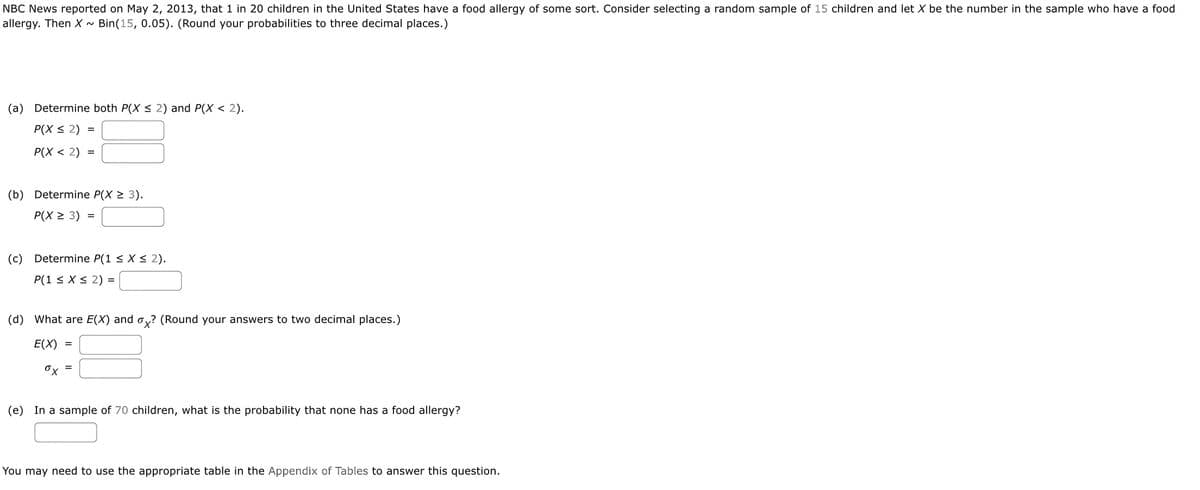NBC News reported on May 2, 2013, that 1 in 20 children in the United States have a food allergy of some sort. Consider selecting a random sample of 15 children and let X be the number in the sample who have a food allergy. Then x - Bin(15, 0.05). (Round your probabilities to three decimal places.) (a) Determine both P(X s 2) and P(X < 2). P(X S 2) = P(X < 2) = (b) Determine P(X 2 3). P(X 2 3) = (c) Determine P(1 sXs 2). P(1 sxS 2) = (d) What are E(X) and o,? (Round your answers to two decimal places.) E(X) = (e) In a sample of 70 children, what is the probability that none has food allergy? You may need to use the appropriate table in the Appendix of Tables to answer this question.
NBC News reported on May 2, 2013, that 1 in 20 children in the United States have a food allergy of some sort. Consider selecting a random sample of 15 children and let X be the number in the sample who have a food allergy. Then x - Bin(15, 0.05). (Round your probabilities to three decimal places.) (a) Determine both P(X s 2) and P(X < 2). P(X S 2) = P(X < 2) = (b) Determine P(X 2 3). P(X 2 3) = (c) Determine P(1 sXs 2). P(1 sxS 2) = (d) What are E(X) and o,? (Round your answers to two decimal places.) E(X) = (e) In a sample of 70 children, what is the probability that none has food allergy? You may need to use the appropriate table in the Appendix of Tables to answer this question.
College Algebra
7th Edition
ISBN:9781305115545
Author:James Stewart, Lothar Redlin, Saleem Watson
Publisher:James Stewart, Lothar Redlin, Saleem Watson
Chapter9: Counting And Probability
Section9.3: Binomial Probability
Problem 2E: If a binomial experiment has probability p success, then the probability of failure is...
Related questions
Question
I need parts b) d) and e) ONLY

Transcribed Image Text:NBC News reported on May 2, 2013, that 1 in 20 children in the United States have a food allergy of some sort. Consider selecting a random sample of 15 children and let X be the number in the sample who have a food
allergy. Then X ~ Bin(15, 0.05). (Round your probabilities to three decimal places.)
(a) Determine both P(X < 2) and P(X < 2).
P(X < 2) =
P(X < 2) =
(b) Determine P(X > 3).
P(X > 3)
(c) Determine P(1 < X < 2).
P(1 < X < 2) =
(d) What are E(X) and o,? (Round your answers to two decimal places.)
E(X) =
Ox =
(e) In a sample of 70 children, what is the probability that none has a food allergy?
You may need to use the appropriate table in the Appendix of Tables to answer this question.
Expert Solution
This question has been solved!
Explore an expertly crafted, step-by-step solution for a thorough understanding of key concepts.
This is a popular solution!
Trending now
This is a popular solution!
Step by step
Solved in 2 steps with 2 images

Recommended textbooks for you

College Algebra
Algebra
ISBN:
9781305115545
Author:
James Stewart, Lothar Redlin, Saleem Watson
Publisher:
Cengage Learning


Algebra & Trigonometry with Analytic Geometry
Algebra
ISBN:
9781133382119
Author:
Swokowski
Publisher:
Cengage

College Algebra
Algebra
ISBN:
9781305115545
Author:
James Stewart, Lothar Redlin, Saleem Watson
Publisher:
Cengage Learning


Algebra & Trigonometry with Analytic Geometry
Algebra
ISBN:
9781133382119
Author:
Swokowski
Publisher:
Cengage